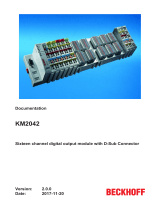
Product Overview
KL8001 and KL906012 Version: 2.0.0
2.3 Power terminal KL8001 - Technical data
KL8001 Power Terminal
Number of power terminals per Bus Coupler 10 max. If you operate two contactors with each power terminal (reversing
contactor connection) then you may only use 5 power terminals with
each Bus Coupler.
Observe also the maximum current [}14] that your Bus Coupler can
supply to the K-bus!
Number of contactors per Bus Coupler 10 max.
Type of fastening and mechanical connec-
tion
Suitable for Siemens contactors of the Sirius 3RT10 series, size S00
Type of connection power path Screw terminals for core cross-sections up to 2 x 2.5mm
2
Power path current loading (back-up fuse) 25A max.
Power path short-circuit strength up to 5000A
Power path internal resistance < 1mΩ
Setting range of rated current
via rotary switch [}10]: 0.9A to 9.9A
via KS2000 [}27] or parameter registers [}34]: 0.9A to 15.0A
Selectable tripping classes CLASS 5, 10, 15, 20, 25, 30 selectable
Measured values Current, voltage, effective power, cos j, energy consumption, switching cycles, operating
hours
Measuring accuracy (at balanced load) 0.15A
rms
; 2V
rms
; 5W; 1kWh
Crosstalk between the channels at unbal-
anced load
up to 3% from the difference
Measuring voltage 500V
Type of K-bus connection 2 x flat plug socket, 10 pin
K-bus current consumption (5V
DC
) typically 150mA
Observe the maximum current [}14] that your Bus Coupler can supply to the K-bus!
Contactor control voltage current consump-
tion (24V
DC
)
When contactor switched off: typically 7mA
When contactor switched on: typically 7mA + current in the contactor coil
Dielectric strength 500V
(power contact/K-bus), 6000V
(mains supply/K-bus)
Behavior under short-circuit conditions conforms to EN 60947-4-1 (assignment type 2)/VDE 102
Triggering tolerance conforms to IEC 947, as well as UL and CSA
Configuration options Automatic over the fieldbus using the KS2000 configuration software, manual (rated cur-
rent)
Width in the process image
96 bits I/O (see description of the process image [}28])
Permissible ambient temperature range dur-
ing operation
0°C ... +55°C
Permissible ambient temperature range dur-
ing storage
-25°C ... +85°C
Permissible relative air humidity 95%, no condensation
Vibration/ shock resistance conforms to EN60068-2-6/ EN60068-2-27
EMC immunity/ emission conforms to EN61000-6-2 / EN61000-6-4
Weight approx. 90g
Dimensions (W x H x D) approx. 45mmx69mmx74mm
Mounting With lugs and connecting pins to Siemens contactors of the 3RT1016 series
Installation position variable (although you must observe the permitted installation positions of the contactors)
Protection class IP20
Approvals CE































